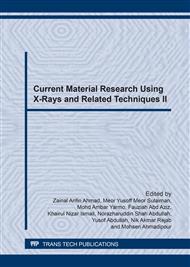p.86
p.91
p.96
p.103
p.108
p.112
p.117
p.121
p.126
Tetragonal and Monoclinic Phase Transformation of ZTA-MgO Ceramic Cutting Tool by Machining Process
Abstract:
The purpose of this study is to investigate the phase transformation route of ZTA-MgO ceramic cutting tool in raw powder form, after sintering process and after machining process. This is to evaluate the effect of phase transformation to the properties of the cutting tool i.e hardness and fracture toughness. Samples of ZTA-MgO ceramic cutting insert were fabricated by wet mixing the materials, and then dried at 100°C before crushed into powder. The powder was pressed into rhombic shape and sintered at 1600°C at 4 hours soaking time to yield dense body. To study the effect of the phase transformation of the fabricated tool, machining was performed on the stainless steel 316L at 2000 rpm cutting speed. XRD analysis were performed on three type of ZTA-MgO samples which were the raw powder, the sintered samples and also the samples after machining process. Results shows that the m-ZrO2 reduced to 0% when sintering process take place and reappear at 12% when the machining process take place proving the occurrence of transformation toughening during the machining process. The consequence of this condition is the hardness of the samples increased by 22% while the fracture toughness decreased by 21.1%.
Info:
Periodical:
Pages:
108-111
Citation:
Online since:
March 2017
Keywords:
Price:
Сopyright:
© 2017 Trans Tech Publications Ltd. All Rights Reserved
Share:
Citation:


